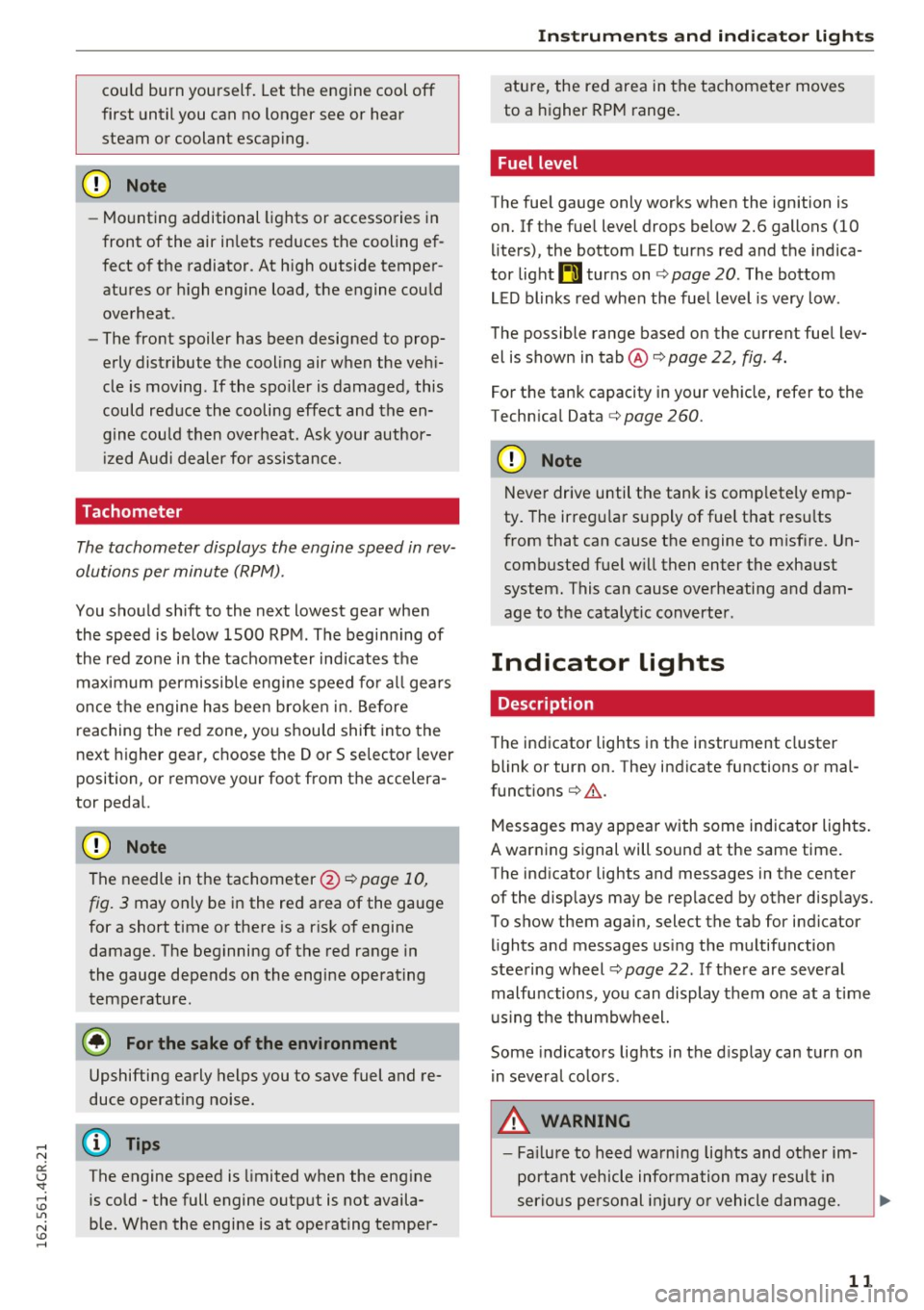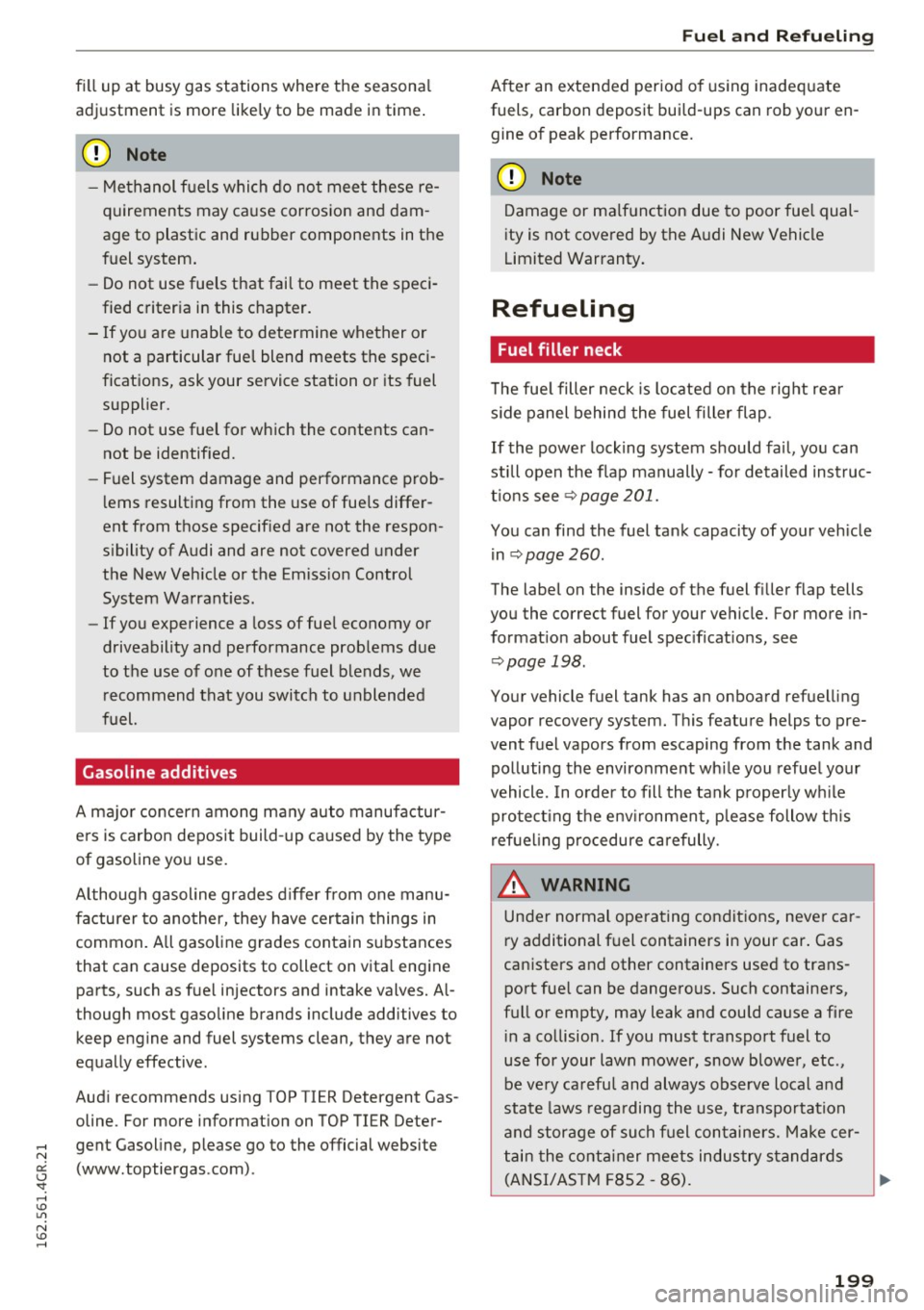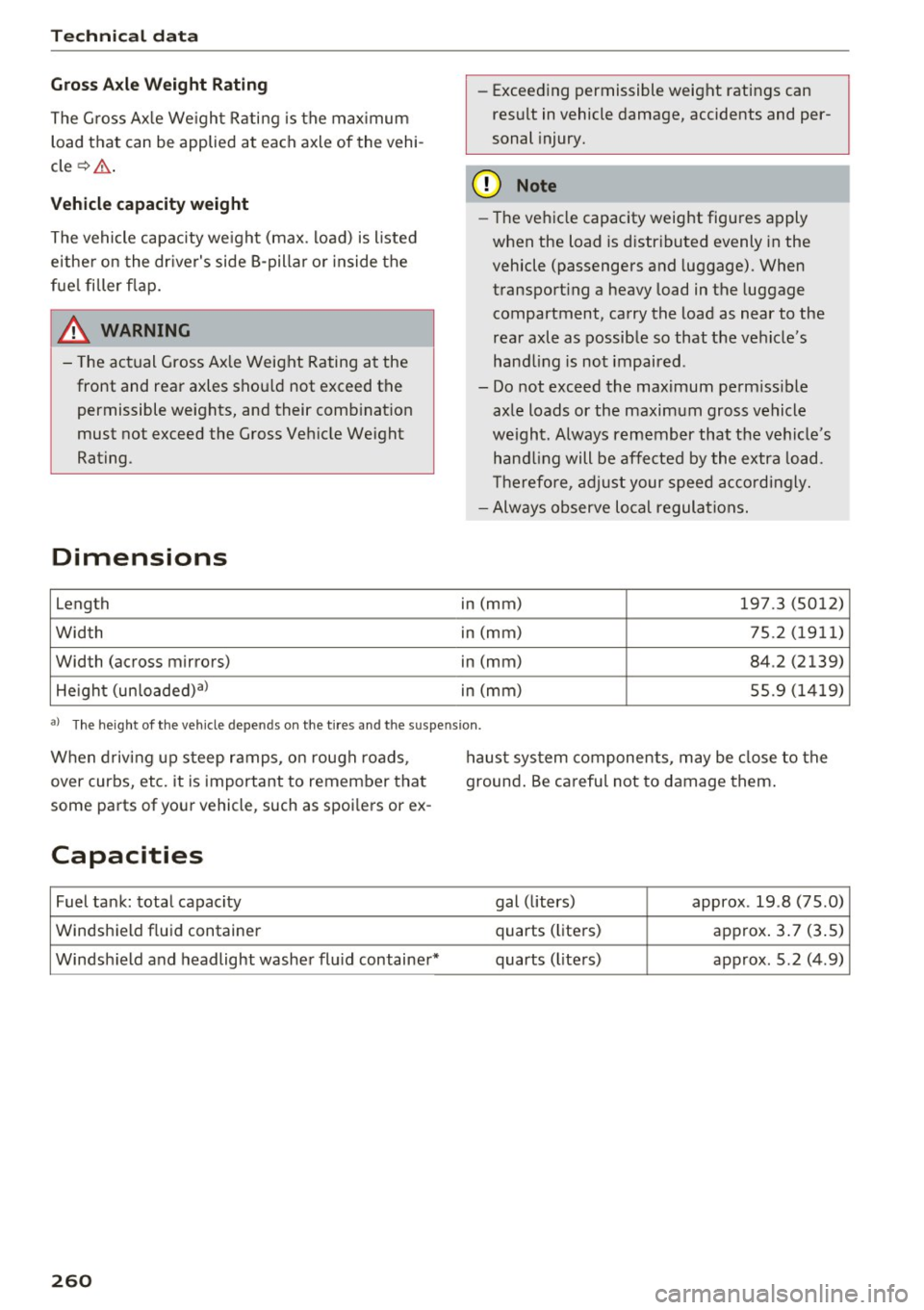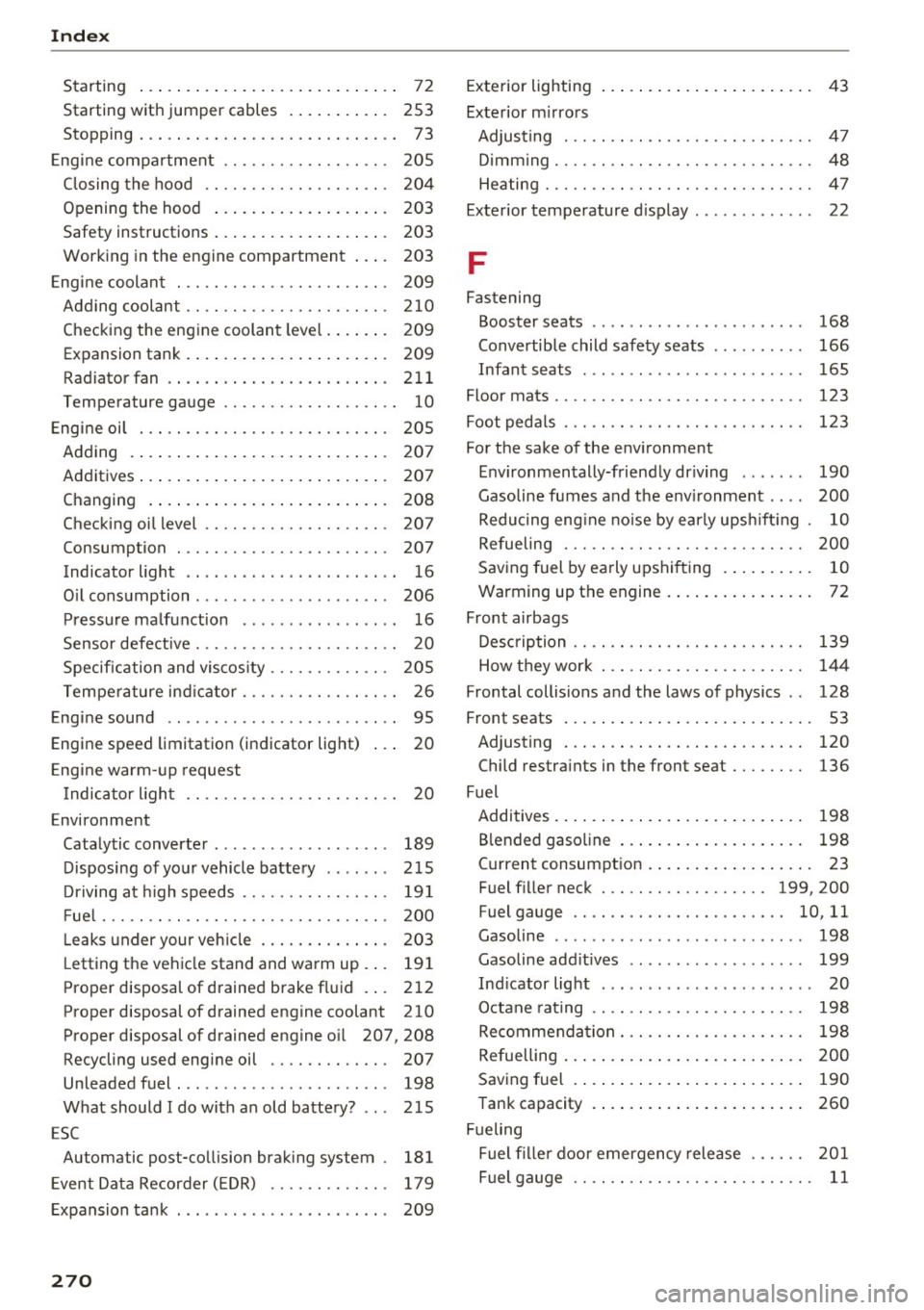fuel tank capacity AUDI RS7 SPORTBACK 2016 Owners Manual
[x] Cancel search | Manufacturer: AUDI, Model Year: 2016, Model line: RS7 SPORTBACK, Model: AUDI RS7 SPORTBACK 2016Pages: 282, PDF Size: 70.78 MB
Page 13 of 282

could burn yourself. Let the engine cool off
first until you can no longer see or hear
steam or coolant escaping .
0 Note
- Mounting additional lights or accessories in
front of the air inlets reduces the cooling ef
fect of the radiator. At h igh outside temper
atures or high engine load, the engine could
overheat .
- The front spoiler has been designed to prop
erly distribute the cooling air when the veh i
cle is moving . If the spoiler is damaged, this
could red uce the cooling effect and the en
gine could then overheat. Ask your author
iz ed Audi dealer for assistance.
Tachometer
The tachometer displays the engine speed in rev
olutions per minute (RPM).
You should shift to the next lowest gear when
the speed is below 1500 RPM . The beginning of
the red zone in the tachometer indicates the
maximum permissib le engine speed for all gea rs
once the engine has been broke n in. Before
reaching the red zone, you should shift into the
next higher gear, choose the Dor 5 selector lever
position , or remove your foot from the accelera
tor pedal.
(D Note
The needle in the tachometer@Q
page 10,
fig. 3
may only be in the red area of the gauge
for a short time or there is a risk of engine
damage. The beginning of the red range in
the gauge depends on the engine operating
tern perature.
@ For the sake of the environment
Upshifting early helps you to save fuel and re
duce operating noise.
{!) Tips
The engine speed is limited when the engine
is cold - the full engine output is not availa
ble. When the engine is at operating temper-
Instruments and indicator lights
ature, the red area in the tachometer moves
to a higher RPM range.
Fuel level
The fuel gauge only works when the ignition is
on. If the fuel level drops below 2.6 gallons (10
liters), the bottom LED turns red and the indica
tor light
tD turns on Q page 20. The bottom
LED blinks red when the fuel level is very low .
The possible range based on the current fuel lev
el is shown in tab@¢
page 22, fig. 4.
For the tank capacity in your vehicle, refer to the
Technical Data¢
page 260.
(D Note
Never drive until the tank is comp letely emp
ty. The irregu lar supply of fuel that resu lts
from that can cause the engine to misfire. Un
combusted fuel w ill then enter the exhaust
system. This can cause overheating and dam
age to the catalytic converter .
Indicator lights
Description
The indicator lights in the instr ument cluster
blink or turn on. They indicate functions or mal
funct ions ¢& .
Messages may appear with some indicator lights .
A warning signal will sound at the same time.
The indicator lights and messages in the center of the displays may be replaced by other disp lays.
To show them again, select the tab for indicator
lights and messages using the multifunction
stee ring wheel ¢
page 22. If there are several
malfunctions, you can display them one at a time
using the thumbwheel.
Some indicato rs lights in the d isplay can turn on
in several colors .
_&. WARNING
- Failure to heed warning lights and other im
portant vehicle information may result in
serious personal injury or vehicle damage.
11
Page 201 of 282

fill up at busy gas st ations where the season al
adjustm ent is mor e likely to be made in time .
(D Note
-Me thanol f uels which do not mee t these re
quirements may ca use corros ion and dam
age to plastic and rubber components in the
fuel system .
- Do not use fuels that fai l to meet the speci
fied criter ia in this chapter.
- If you are unable to determine whether or not a particular fuel blend meets the speci
ficat ions, ask your service station or its fuel
supplier.
- Do not use fuel for which the contents can
not be identif ied.
- Fuel system damage and performance prob
lems resulting from the use of fue ls differ
ent from those specified are not the respon
s ibility of Audi and are not covered under
the New Veh icle or the Emiss ion Control
System Wa rrant ies.
- If you experience a loss of fue l economy or
driveability and performance prob lems due
to the use of one of these fuel b lends , we
recommend that you switch to unblended
fuel.
Gasoline additives
A ma jo r concern among many au to manufactur
e rs is carbon deposit build-up caused by the type
of gasoline you use.
A lthough gasoline gr ades d iffer from one manu
facturer to ano ther, they have cer tain things in
common . All gasoline grades contain substances
that can cause deposits to coll ect on v ita l eng ine
parts, such as f uel injectors and intake valves. Al
though most gasoline brands include additives to
keep engine and fuel systems clean, they are not
equally effective.
Aud i recommends using TOP TIER Detergent Gas
oline. For more informat ion on TOP TIER Deter -
,... gent Gasoline, please go to the official website
N
t3 (www .toptiergas .com) .
'SI: ....
After an extended period o f using inadeq uate
fuels, carbon deposit bui ld-ups can rob your en
gine o f peak performance.
(D Note
Damage or ma lf u nction due to poor fuel qual
ity is not covered by the A udi New Vehicle
Limited Warranty .
Refueling
Fuel filler neck
The fue l filler neck is located on the rig ht rea r
s ide panel behind the fuel filler flap .
If the power lock ing system shou ld fai l, yo u can
still open the flap manually -fo r detailed inst ruc
t io ns see c:>
page 201.
You can find the fuel tank capacity of your vehicle
i n c:>
page 260 .
The label on the inside of the fuel f iller flap tells
you the correct fuel for your vehicle. For more in
format ion about fuel spec ificat ions, see
c=> page 198 .
Your vehicle fuel tank has an on board refuelling
vapor recovery system. T his feature helps to pre
vent fuel vapors from escaping from the tank and polluting the environme nt wh ile you refuel your
vehicle . In o rder to fill the tank p roper ly w hile
pro tect ing t he e nvir onment, p lease follow th is
ref ue ling pro cedure ca re fully.
A WARNING
Under normal opera ting cond itions, neve r ca r
ry additional f uel containers in your car . Gas
canisters and other containers used to trans
port fue l can be dange rous. Such containe rs,
full or empty, may leak and could cause a fire
i n a co llision. If you must transport fuel to
use for your lawn mower, snow blower, etc .,
be ve ry ca reful and always observe local and
state laws rega rding the use, transportation
a nd stor age of su ch f uel con tainers. Make cer
t ai n t he cont ainer meets industry stand ards
(A NSI/AS TM F852 -86).
199
Page 262 of 282

Tech nical data
Gross Axle Weight Rating
The G ross Ax le We ight Rating is the max imum
load that can b e applied at each axle of the vehi
cle ¢& .
Vehicle capacity weight
The vehicle capacity we ight (max . load) is l isted
eithe r on the dr iver's side 8-pilla r or inside the
fue l filler f lap.
A WARNING
- The ac tual Gross Axle Weight Rating at the
front and rear axles shou ld not exceed the
permissible weights, and their comb inat ion
must not exceed the Gross Veh icle Weight
Rating .
Dimensions
length
Width
Width (across mirro rs)
He ight (un lo aded) al -
Exceed ing permissible weight ratings can
result in vehicle damage, accidents and per
sonal injury.
(D Note
- The vehicle capacity weight figures apply
when the load is d istr ibuted evenly in the
vehicle (passengers and luggage) . When
t ransporting a heavy load in the luggage
compartment, carry the load as near to the
rea r axle as possib le so that the vehicle's
hand ling is not impaired .
- Do not exceed the max imum perm iss ible
axle loads or the maximum gross vehicle
we ight. Always remember that the ve hicle 's
han dling will be affe cted by the extra load .
T herefore , ad just your speed ac co rd ingly.
- Always observe lo cal regulations.
in (mm) 197.3 (5012)
in (mm) 75.2 (19 11)
in (mm) 84.2 (2139)
in (mm) 55.9 (1 419)
al The he ight of the veh icle depe nd s on the ti re s an d th e su spensio n.
When drivi ng up s teep r amps , on rough roads ,
over curbs, etc. it is important to remember that
some parts of yo ur vehicle, such as spoi lers or ex -
Capacities
Fuel tank: total capac ity
Windshie ld fluid container
Windsh ield and headlight washe r fl ui d containe r*
260
haust sys tem components , may be close to the
ground . Be ca refu l not to damage them .
gal (liters) approx. 19 .8 (75 .0)
quarts (liters) approx. 3 .7 (3 .5)
quarts (l ite rs) approx. 5.2 (4 .9)
Page 272 of 282

Index
Starting . . . . . . . . . . . . . . . . . . . . . . . . . . . . 72
Starting with jumper cables . . . . . . . . . . . 253
Stopping . . . . . . . . . . . . . . . . . . . . . . . . . . . . 73
Engine compartment . . . . . . . . . . . . . . . . . . 205
Closing the hood . . . . . . . . . . . . . . . . . . . . 204
Opening the hood . . . . . . . . . . . . . . . . . . . 203
Safety instructions . . . . . . . . . . . . . . . . . . . 203
Working in the engine compartment . . . . 203
Engine coolant . . . . . . . . . . . . . . . . . . . . . . . 209
Adding coolant .. ............. .... .. . 210
Checking the engine coolant level. . . . . . . 209
Expansion tank . . . . . . . . . . . . . . . . . . . . . . 209
Radiator fan .... ................ .... 211
Temperature gauge . . . . . . . . . . . . . . . . . . . 10
Engine oil . . . . . . . . . . . . . . . . . . . . . . . . . . . 205
Adding . . . . . . . . . . . . . . . . . . . . . . . . . . . . 207
Additives . . . . . . . . . . . . . . . . . . . . . . . . . . . 207
Changing . . . . . . . . . . . . . . . . . . . . . . . . . . 208
Checking oil level . . . . . . . . . . . . . . . . . . . . 207
Consumption . . . . . . . . . . . . . . . . . . . . . . . 207
Indicator light . . . . . . . . . . . . . . . . . . . . . . . 16
Oil consumption . . . . . . . . . . . . . . . . . . . . . 206
Pressure malfunction . . . . . . . . . . . . . . . . . 16
Sensor defective . . . . . . . . . . . . . . . . . . . . . . 20
Specification and viscosity . . . . . . . . . . . . . 205
Temperature ind icator . . . . . . . . . . . . . . . . . 26
Eng ine sound . . . . . . . . . . . . . . . . . . . . . . . . . 95
Engine speed limitation (indicator light) 20
Engine warm-up request
I ndicator l ight . . . . . . . . . . . . . . . . . . . . . . .
20
Environment
Catalytic converter . . . . . . . . . . . . . . . . . . .
189
Disposing of your vehicle battery . . . . . . . 215
Driving at high speeds . . . . . . . . . . . . . . . . 191
Fuel. .... .. .. .. ... .......... .. .. .. . 200
Leaks under your vehicle . . . . . . . . . . . . . . 203
Letting the vehicle stand and warm up. .. 191
Proper disposal of drained brake fluid . . . 212
Proper disposal of drained engine coolant 210
Proper disposal of drained engine oil 207, 208
Recycling used engine oil . . . . . . . . . . . . . 207
Unleaded fuel . . . . . . . . . . . . . . . . . . . . . . . 198
What should I do with an old battery? . . . 215
ESC
Automatic post-co llision braking system .
181
Event Data Recorder (EDR) . . . . . . . . . . . . . 179
E . k xpans1on tan . . . . . . . . . . . . . . . . . . . . . . . 209
270
Exterior lighting . . . . . . . . . . . . . . . . . . . . . . . 43
Exterior mirrors
Adjusting . . . . . . . . . . . . . . . . . . . . . . . . . . . 47
D' .
1mming ............................
48
Heating... .. .. .. .. .. ............. ... 47
Exterior temperature display . . . . . . . . . . . . .
22
F
Fastening
Booster seats . . . . . . . . . . . . . . . . . . . . . . .
168
Convertible child safety seats . . . . . . . . . . 166
Infant seats . . . . . . . . . . . . . . . . . . . . . . . . 165
Floor mats . . . . . . . . . . . . . . . . . . . . . . . . . . . 123
Foot pedals . . . . . . . . . . . . . . . . . . . . . . . . . . 123
For the sake of the environment
Environmentally-friendly driving . . . . . . .
190
Gasoline fumes and the environment . . . . 200
Reducing eng ine noise by early upsh ifting . 10
Refueling . . . . . . . . . . . . . . . . . . . . . . . . . . 200
Saving fuel by early upshifting . . . . . . . . . . 10
w . th .
arming up e engine . . . . . . . . . . . . . . . . 72
Front airbags
D . t· escnp 10n . . . . . . . . . . . . . . . . . . . . . . . . . 139
How they work . . . . . . . . . . . . . . . . . . . . . . 144
Frontal collisions and the laws of physics . . 128
Front seats . . . . . . . . . . . . . . . . . . . . . . . . . . . 53
Adjusting . . . . . . . . . . . . . . . . . . . . . . . . . . 120
Child restraints in the front seat . . . . . . . . 136
Fuel
Additives . . . . . . . . . . . . . . . . . . . . . . . . . . .
198
Blended gasoline . . . . . . . . . . . . . . . . . . . . 198
Current consumpt ion . . . . . . . . . . . . . . . . . . 23
Fuel filler neck . . . . . . . . . . . . . . . . . . 199, 200
Fuel gauge . . . . . . . . . . . . . . . . . . . . . . . 10, 11
Gasoline . . . . . . . . . . . . . . . . . . . . . . . . . . . 198
Gasoline additives . . . . . . . . . . . . . . . . . . . 199
Indicator light . . . . . . . . . . . . . . . . . . . . . . . 20
Octane rating . . . . . . . . . . . . . . . . . . . . . . . 198
Recommendation. . . . . . . . . . . . . . . . . . . . 198
Refuelling . . . . . . . . . . . . . . . . . . . . . . . . . . 200
Saving fuel . . . . . . . . . . . . . . . . . . . . . . . . . 190
T k . an capacity . . . . . . . . . . . . . . . . . . . . . . . 260
Fueling
Fuel filler door emergency release . . . . . .
201
Fuel gauge . . . . . . . . . . . . . . . . . . . . . . . . . . 11